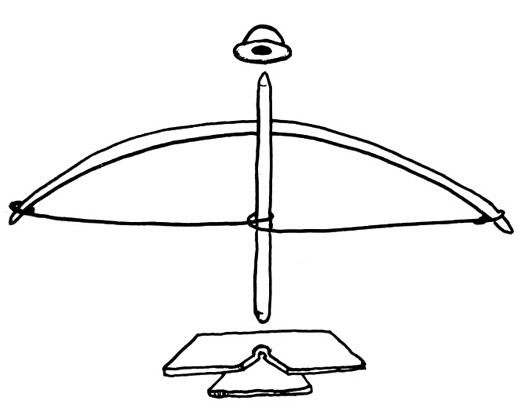Fire: visable active combustion of wood or other fuels used to cook, warm, dry, or signal. See the No Heat section tor site selection, optional starting techniques, and fueling suggestions. Fire building skills will serve you well in many survival situations. Practice by learning how to start a fire with tinder and a bow drill. As previously noted, tinder is a nest-shaped ball that you can make from plant fibers, shredded bark or wood shavings, or other dry combustible items. It is used to help start a fire. The bow drill consists of a drill or spindle, bow and socket, and a fireboard made of soft wood. A good drill is about 1 inch in diameter and 12 inches long. One end is pointed to fit the socket hole, and the fireboard end is round. A bow should be about 2 inches in diameter and 2 feet in length. The bowstring can be made of leather, vine, lace, cord, plant fiber, or whatever. Carve a 1-inch diameter friction-pocket near the edge of the fireboard, and cut a V-notch from the outside of the board to the center of same. Widen the V-notch on the bottom to help collect the spark. The pocket is best made from a flat stone with a hole pecked into the corner. It should easily fit your hand. Assemble the parts and use as illustrated. Apply more pressure and speed until the drill makes a fine black powder and lots of smoke. When ember appears, fan slightly and transfer to tinder bundle. Pick up the bundle and gently blow a spark into a flame. Use this to start a fire.

Bow Drill operating instructions: Kneel with left foot holding the fireboard. If right handed, your left hand holds the socket which holds the upper end of the drill. Your right hand holds the bow, and an arm motion pulls it quickly back and forth. The left arm pushes it down to press the drill into the friction pocket. The procedure is reversed if you are left handed.
Once the fire is started, add split wood. It will burn better than large pieces. Use the fire to burn logs in two and reduce these to usable size. Add rock reflectors around three sides of the fire to direct heat back toward the open side and you. Select hard woods for heat and soft woods for light. Protect hot coals from wind to keep the fire alive. Prepare additional tinder for traveling or fire starting purposes by baking until powder dry. Carry tinder in a dry container or wrap it inside strips of bark. Use flames of fire for boiling and baking. Hot coals can usually be stirred up using a fire blower made from a hollow plant stem. Move coals or burning wood with fire tongs or poker made from green wood. This will save fingers from burns. Make a fire bundle to transport the fire. This is made by forming a 2-inch diameter, 8-inch long compressed bundle of shredded vegetation wrapped in several thicknesses of dry stripped bark or strong plant fibers. Leave it hollow in one end, and place a hot coal there to light. One bundle will carry a hot spark about 8 hours. Have a reserve fire bundle in case your travel time is longer than this.